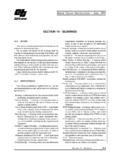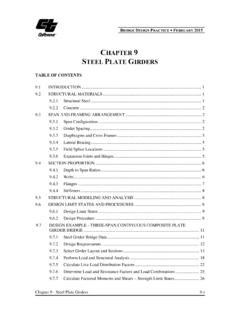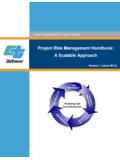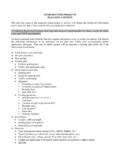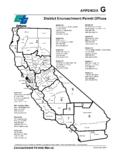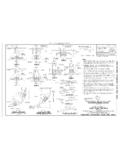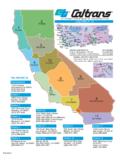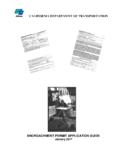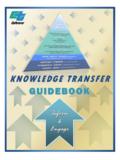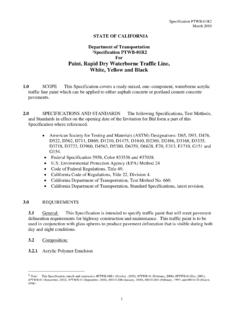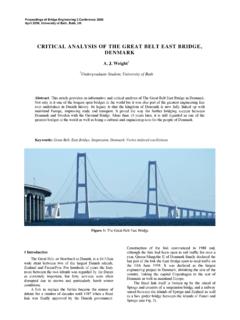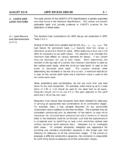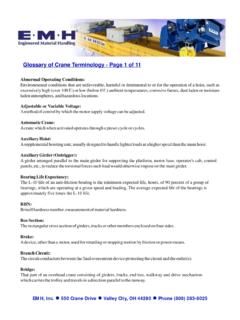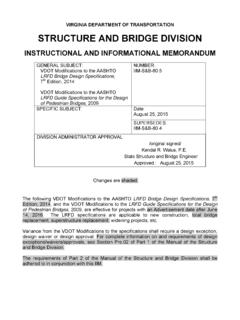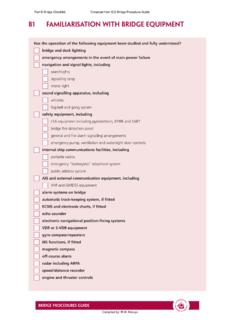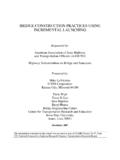Transcription of SECTION 7 - SUBSTRUCTURES
1 bridge DESIGN SPECIFICATIONS APRIL 2000 SECTION 7 - SUBSTRUCTURES + + + + + + Part A General Requirements and Materials GENERAL Definition A substructure is any structural, load supporting com-ponent generally referred to by the terms abutment, pier, retaining wall, foundation or other similar terminology. Loads Where appropriate, piers and abutments shall be de-signed to withstand dead load, erection loads, live loads on the roadway, wind loads on the superstructure, forces due to stream currents, floating ice and drift, temperature and shrinkage effects, lateral earth and water pressures, scour and collision and earthquake loadings. Settlement The anticipated settlement of piers and abutments should be estimated by appropriate analysis, and the effects of differential settlement shall be accounted for in the design of the superstructure.
2 Foundation and Retaining Wall Design Refer to SECTION 4 for the design of spread footing, driven pile and drilled shaft foundations and SECTION 5 for the design of retaining walls. NOTATIONS The following notations shall apply for the design of pier and abutment substructure units: B = Width of foundation (ft) e = Eccentricity of load from foundation centroid in the indicated direction (ft) H = Height of abutment (ft) The notations for dimension units include the follow-ing: ft = foot. The dimensional units provided with each notation are presented for illustration only to demon-strate a dimensionally correct combination of units for the design procedures presented herein.
3 If other units are used, the dimensional correctness of the equations should be confirmed. Part B Service Load Design Method Allowable Stress Design PIERS Pier Types Pier Walls Pier walls are designed as columns for forces and moments acting about the weak axis and as piers for those acting about the strong axis. Pier walls are defined as a bridge support system consisting of a wall on a footing or piles. Ratio of clear height to maximum width is less than Double Wall Piers More recent designs consist of double walls, spaced in the direction of traffic, to provide support at the continu-ous soffit of concrete box superstructure sections. These walls are integral with the superstructure and must also be designed for the superstructure moments which develop from live loads and erection conditions.
4 Bents Bents are a bridge support system consisting of one or more columns supporting a single cap. Columns are defined as a single support member having a ratio of clear height to maximum width of or greater. The columns + + + + + + + + + + + + + + + + + SECTION 7 SUBSTRUCTURES 7-1 bridge DESIGN SPECIFICATIONS APRIL 2000 may be supported on a spread- or pile-supported footing, or a solid wall shaft, or they may be extensions of the piles or shaft above the ground line. + Deleted Pier Protection Collision Where the possibility of collision exists from highway or river traffic, and appropriate risk analysis should be made to determine the degree of impact resistance to be provided and/or the appropriate protection system.
5 Collision Walls Collision walls extending 6 feet above top of rail are required between columns for railroad overpasses, and similar walls extending feet above ground should be considered for grade separation structures unless other protection is provided. Scour The scour potential must be determined and the design must be developed to minimize failure from this condi-tion. Facing Where appropriate, the pier nose should be designed to effectively break up or deflect floating ice or drift. In these situations, pier life can be extended by facing the nosing with steel plates or angles, and by facing the pier with granite. TUBULAR PIERS Materials Tubular piers of hollow core SECTION may be of steel, reinforced concrete or prestressed concrete, of such cross SECTION to support the forces and moments acting on the elements.
6 Configuration The configuration can be as described in Article and, because of their vulnerability to lateral loadings, shall be of sufficient wall thickness to sustain the forces and moments for all loading situations as are appropriate. Prismatic configurations may be sectionally precast or prestressed as erected. ABUTMENTS Abutment Types Seat Type Abutment Seat type abutments are located at or near the top of approach fills, with a backwall depth sufficient to accom-modate the structure depth and bearings which sit on the bearing seat. Partial-Depth Abutment Partial-depth abutments are located approximately at mid-depth of the front slope of the approach embank-ment.
7 The higher backwall and wingwalls may retain fill material, or the embankment slope may continue behind the backwall. In the latter case, a structural approach slab or end span design must bridge the space over the fill slope, and curtain walls are provided to close off the open area. Inspection access should be provided for this situ-ation. Full-Depth Abutment Full-depth abutments are located at the approximate front toe of the approach embankment, restricting the opening under the structure. Diaphragm Abutment Diaphragm abutments are rigidly attached to the su-perstructure and are supported on spread or deep founda-tions capable of permitting necessary horizontal move-ments.
8 Loading Abutments shall be designed to withstand earth pres-sure as specified in Article and , the weight of the abutment and bridge superstructure, live load on the superstructure or approach fill, wind forces and longitu-dinal forces when the bearings are fixed, and longitudinal forces due to friction or shear resistance of bearings. The design shall be investigated for any combination of these forces which may produce the most severe condition of + + + + SECTION 7 SUBSTRUCTURES 7-2 bridge DESIGN SPECIFICATIONS APRIL 2000 + loading. Diaphragm abutments must be designed for spread footings founded or keyed into rock. Movement forces generated by thermal movements of the superstruc-calculations shall consider temperature, creep, and long-ture.
9 Term prestress shortening in determining potential move-ments of abutments. Stability Maximum span lengths, design considerations, de-tails should comply with recommendations outlined in Abutments shall be designed for the loading combina-FHWA Technical Advisory T (1980) except tion specified in Article where substantial local experience indicates otherwise. To avoid water intrusion behind the abutment, the + Abutments on spread footings shall be designed to approach slab should be connected directly to the abut-+ resist overturning (FS ) and sliding (FS ). ment (not to wingwalls), and appropriate provisions + Dead and live loads are assumed uniformly distrib-should be made to provide for drainage of any entrapped + uted over the length of the abutment between water.
10 + + expansion joints. Allowable foundation pressures and pile capacities Deleted + + shall be determined in accordance with Articles + and Deleted + + + + + + The earth pressures exerted by fill in front of the abutment shall be neglected. Earth pressures when active wedge cannot occur ( strutted abutments) should be addressed in SECTION 5. Wingwalls Length + The earth pressures exerted by the fill material shall Wingwalls shall be of sufficient length to retain the + be calculated in accordance with Articles and roadway embankment to the required extent and to fur-+ nish protection against erosion. The wingwall lengths + The cross SECTION of stone masonry or plain con-shall be computed using the required roadway slopes.
